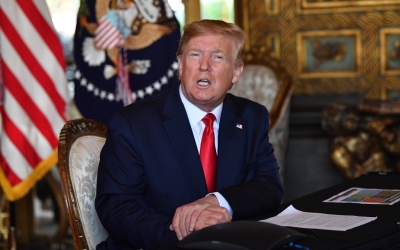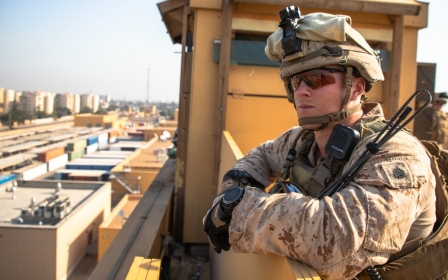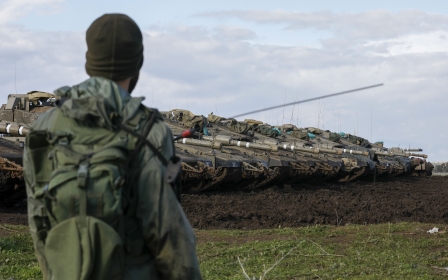Tracked, targeted, killed: Qassem Soleimani's final hours

Stepping off his Cham Wings flight and onto the tarmac of Baghdad airport, Qassem Soleimani was met by a familiar face.
Abu Mahdi al-Muhandis, deputy head of the Hashd al-Shaabi Iraqi paramilitary, was a longstanding ally of the Iranian general and a close friend.
With him was a small reception party and two vehicles, ready to whisk the head of Iran's Quds force back to Muhandis' Green Zone home, his usual address in the Iraqi capital, according to Shia leaders in the country.
This time, something was wrong. Above them was a US drone hovering and ready to strike, and within minutes the two men would be dead.
Who was Qassem Soleimani?
+ Show - HideIranian Major-General Qassem Soleimani, the shadowy top commander of the Quds Force of the Revolutionary Guards, helped Iran fight proxy wars and increase its foothold across the Middle East.
His assassination in a US air strike on his convoy at Baghdad airport on 3 January marked the end of a man who was celebrated at home and closely watched by the US, Israel and Tehran's regional rival Saudi Arabia.
From working as a teenager to pay off his father’s debts to a swift rise in Tehran’s elite force, Soleimani, 62, was responsible in the end for Iran’s clandestine overseas operations and was often seen on battlefields guiding Iraqi Shia groups in the war against Islamic State.
He was born into an agricultural family in the village of Qanat-e Malek in southeast Iran in 1957. At 13, he moved to the town of Kerman to work in construction and help his father pay back loans, according to a first-person account from Soleimani posted by Defa Press, a site focused on the history of Iran’s eight-year war with Iraq.
When the revolution to oust the shah began in 1978, Soleimani was working for Kerman's municipal water department and organised demonstrations against the monarch. He volunteered for the Revolutionary Guard and, after war with Iraq broke out in 1980, quickly rose through the ranks and went on to battle drug smugglers on the border with Afghanistan.
In 1998, he became chief of the Quds Force, a post in which he helped Iran form regional alliances as it came under pressure from the US sanctions that have devastated its economy. He kept a low profile in this position while he strengthened Iran’s ties with Hezbollah in Lebanon, Syrian President Bashar al-Assad's government and militia groups in Iraq.
At the height of the civil war between Sunni and Shia militants in Iraq in 2007, the US military accused the Quds Force of supplying improvised explosive devices to Shia militants which led to the death of many American soldiers.
As the Americans struggled to stabilise the country and were looking for a broker to help, Soleimani wrote to US General David Petraeus, then commanding US forces in Iraq, in 2008.
"General Petraeus, you should know that I, Qassem Suleimani, control the policy for Iran with respect to Iraq, Lebanon, Gaza and Afghanistan," the commander reportedly wrote in a phone text.
"The ambassador in Baghdad is a Quds Force member. The individual who's going to replace him is a Quds Force member."
Soleimani was arguably even more influential in Syria. Under him, the Quds Force shored up support for Assad when he looked close to defeat in the civil war that has been raging since 2011. His visit to Moscow in the summer of 2015 was the first step in planning for a Russian military intervention that reshaped the Syrian war and forged a new Iranian-Russian alliance in support of Assad.
His activities had made him a repeated target of the US Treasury: Soleimani was sanctioned by the United States for the Quds Force's support for Lebanon's Hezbollah and other armed groups, for his role in Syria’s crackdown against protesters and his alleged involvement in a 2011 plot to assassinate Adel al-Jubeir, then the Saudi ambassador to the United States.
Soleimani’s success in advancing Iran’s agenda had put him in the crosshairs of regional foes Saudi Arabia and Israel even before the US assassination on Friday. In 2017, top Saudi intelligence officials looked into the possibility of using private companies to kill Soleimani, according to the New York Times.
He was killed along with top Iraqi militia commander Abu Mahdi al-Muhandis. Both men were seen as heroes in Iran's fight against its enemies and state television heaped them with praise after their deaths were announced. A Revolutionary Guard spokesman cried during a live broadcast.
Soleimani and Muhandis had been on the United States' most-wanted list for years, and the two avoided using modern technology and followed strict security measures to keep them out of US hands, leaders of armed factions close to both men told Middle East Eye.
New MEE newsletter: Jerusalem Dispatch
Sign up to get the latest insights and analysis on Israel-Palestine, alongside Turkey Unpacked and other MEE newsletters
The number of people with access to them was strictly limited, and for the most part, the two made efforts to keep a low profile when moving around.
"These are their ideal security measures. They have always travelled without prior dates and without announcing their destination, and they use regular airlines," a leader close to Muhandis told MEE.
"They do not pass through the regular formal channels to stamp their passports at the airports. They do not use smartphones, and they move in ordinary cars with the fewest possible number of people," the leader added. Like everyone interviewed, he spoke on condition of anonymity for security reasons.
"Overall, it was difficult to track them. But the Damascus and Baghdad airports are full of pro-American intelligence sources, and because of this they have been hunted down."
Beirut rendezvous
According to Iraqi officials familiar with Soleimani's movements, the man charged with leading Iran's armed forces abroad had several commonly used points of entry into Iraq.
Occasionally, as on Friday, he would land at Baghdad International Airport. Sometimes he would arrive at Najaf's instead, or cross from Iran at the Munthiriya border crossing in Diyala governorate, some 120km east of Baghdad.
Increasingly, he had been flying into northern Iraq's Kurdistan region, before travelling south to Baghdad by car.
None of those other routes would have saved Soleimani, a leader of the Iran-backed Lebanese Hezbollah movement told MEE, as he instead had been betrayed by "his itinerary during the last 36 hours".
'It sounds like he was closely monitored from the moment he arrived in Damascus from Tehran on Thursday until he was assassinated in Baghdad'
- Hezbollah leader
"It sounds like he was closely monitored from the moment he arrived in Damascus from Tehran on Thursday until he was assassinated in Baghdad on Friday," the Hezbollah leader said.
Soleimani had arrived at Damascus airport on Thursday morning. He did not meet anyone in the Syrian capital and moved directly from the plane to a car that carried him to Beirut, where he met Hezbollah secretary-general Hassan Nasrallah.
"They sat for hours discussing the latest developments in Iraq, especially with regard to the US air strikes that recently hit [Iraqi paramilitary] Kataeb Hezbollah and the attack on the American embassy in Baghdad a few days ago," the Hezbollah leader, who is familiar with the discussions, told MEE.
The aim of the talks, the Lebanese said, was to help coordinate the work of Iran-backed armed factions in the region and prepare them for any confrontation with the US.
The talks also, he said, were held "to resolve outstanding problems between some of the factions, especially those linked to Nasrallah".
Arrival in Baghdad
Soleimani took no longer in Beirut than he needed to, and returned to Damascus that evening using the same procedures.
At Damascus airport, Soleimani boarded a Cham Wings flight to Baghdad alongside other passengers. The scheduled flight departure time was set at 20:20, but for unknown reasons, it was delayed to 22:28, the public data of the company shows.
At around the same time, Muhandis received news that suggested his friend would shortly be touching down in Iraq. The Hashd al-Shaabi's top leader was given a very short note, detailing only the airline and arrival time.
Muhandis, one of the most powerful figures in Iraq and Iran's point man, is known to ride around Baghdad in an open-top car. But not this night.
Instead, he summoned Mohammed Redha, a close aide responsible for the Hashd al-Shaabi's arrangements in the airport, and ordered him to drive him to the terminal and prepare for a special guest.
Baghdad International Airport has been subject to strict security measures since 2003, and its security is managed by the British company G4S under the supervision of the Iraqi intelligence and national security services.
Iraqi counterterrorism forces, in cooperation with the US, are meanwhile responsible for securing the airport perimeter, its airspace and the roads leading to it.
Security measures require ordinary passengers heading in and out of the airport to pass through several checkpoints deployed along 10km of road extending between Abbas bin Firnas Square, the last point personal cars can reach, and the departure halls.
As for travellers and officials who have a special escort, they are allowed to pass on VIP roads, which do not require more than informing a checkpoint there of the travellers' identity and the vehicles' physical and registration details.
Any information that reaches this point is shared with airport security, national security and intelligence, as well as with G4S.
Muhandis was seen by the US and his Iraqi rivals as the most dangerous man in Iraq, the executor of Iranian will. He has been monitored by the Americans for years, and it was no secret that Redha transported no one but Muhandis.
It was also, leaders close to Muhandis told MEE, well-known that the Hashd al-Shaabi chief received no one at the airport other than Soleimani.
A US source familiar with the latest developments told MEE that Americans received intelligence that Soleimani was on his way to Baghdad and that Muhandis would receive him at the airport and take him to his home in the heavily fortified Green Zone.
Three Iraqi security officials and several Hashd al-Shaabi leaders confirmed this was the plan.
The trap is set
The journey from Damascus to Baghdad took an hour and five minutes, according to Cham Wings’ public data. The plane landed at 12:32 am Baghdad time.
Soleimani and his two companions, one of whom was his son-in-law, were not kept waiting, with Muhandis and his entourage keen to set off and not make the meeting any more conspicuous. National security officials handled the guests' travel documents and collected their luggage.
The Hyundai Starks minibus and Toyota Avalon did not travel far before three explosions rocked Baghdad's western outskirts.
According to a national security report seen by MEE, the blasts hit Baghdad airport at 1.45 am, and initial investigations have concluded that three guided missiles were fired at the two vehicles.
The Hyundai Starks, travelling around 100-120 metres from the other vehicle, was struck first with one missile.
A second rocket narrowly missed the Toyota, which attempted to speed away. A third finished the job.
The Iraqi authorities needed several hours to identify the victims, some of whom had been completely torched.
Soleimani, however, was easy to spot, thanks to a large and distinctive ring he wore on his left hand, embedded with a dark red stone, security officials told MEE.
"The operation was carried out by drone. It was very significant, accurate, and not an improvised operation. And the information we gathered revealed that the drone was hovering, waiting for their departure," a prominent Hashd al-Shaabi leader told MEE.
Briefly jeopardising the US operation, the Hashd leader said, were two cars that passed Soleimani's convoy as it headed out of the airport, though the drone was able to target the vehicles nonetheless.
"We know that the Americans have been chasing the two men for a long time, but without success. It is clear that they [the Americans] have recruited some people close to the two to follow their movements and determine the place and time to assassinate them," the paramilitary leader added.
"The leaders of the armed factions now are terrified because they do not know to what degree the Americans have infiltrated them, nor do they know what will happen next."
This article is available in French on Middle East Eye French edition.
Middle East Eye delivers independent and unrivalled coverage and analysis of the Middle East, North Africa and beyond. To learn more about republishing this content and the associated fees, please fill out this form. More about MEE can be found here.






